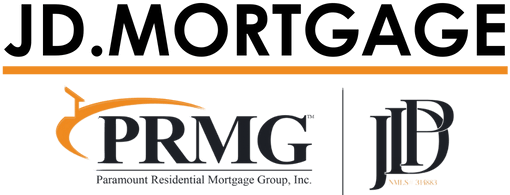Lower your payment, access equity, or lock a fixed rate. See clear scenarios for rate‑and‑term, cash‑out, and streamline refinance options.

Contact the JD.Mortgage team.
Mortgage Refinance: Lower Your Payment, Shorten Your Term, or Tap Equity
A mortgage refinance replaces your current home loan with a new one—ideally with a better rate, payment, or structure for your goals. Whether you’re aiming to lower your monthly payment, switch from an adjustable to a fixed rate, remove mortgage insurance, shorten your term, or pull cash out for debt consolidation, the JD.Mortgage team at PRMG will guide you with no-nonsense advice and a process designed for speed and clarity across 49 states (excluding NY).
Explore refinance options or
ask us a question now.
Popular Mortgage Refinance Options (and When Each Makes Sense)
Rate-and-Term Refinance. This is the classic refi: replace your existing mortgage with a new rate and/or term—often to drop your payment, move from a 30-year to a 15-year, or switch from an ARM to a fixed rate. It can also remove monthly mortgage insurance on certain loans once equity or program criteria are met. If you’ve built equity or your credit improved since the original loan, this may deliver a meaningful payment improvement.
See how to time your break-even or
learn how our process works.
Cash-Out Refinance. Replace your loan and take cash out from available equity to consolidate high-interest debts, fund renovations, or finance large upcoming expenses. Many homeowners compare cash-out to a HELOC or closed-end second; the right choice depends on your loan balance, blended rate, payoff plan, and whether you want a fixed monthly payment.
Compare cash-out vs. second mortgage/HELOC or
review second mortgage options.
VA IRRRL (Interest Rate Reduction Refinance Loan). For eligible veterans and service members with an existing VA loan, the IRRRL is a streamlined way to lower your rate/payment—often with less documentation and faster closings. The JD.Mortgage team is known for helping VA borrowers other lenders can’t or won’t; we understand residual income, manual underwriting, and real-world documentation challenges.
Learn about VA IRRRL or
see our VA expertise.
FHA Streamline Refinance. If you currently have an FHA loan, the FHA Streamline can reduce your rate/payment with minimal documentation in many cases. It’s popular when rates improve and for borrowers who value simpler verification.
Read about FHA Streamline or
visit our FHA page.
When to Refinance: Rate, Payment, and the Break‑Even Check
Refinancing makes sense when the expected savings or benefits exceed the costs within a timeframe you’re comfortable with. A practical way to decide is a break‑even analysis: divide total costs by the monthly savings to estimate how many months it will take to “recoup” the expense. If you plan to keep the home longer than that, or you’re using cash‑out to eliminate expensive debt, the refi often pencils out. We’ll run both payment and long‑term interest comparisons—not just monthly savings—to help you choose confidently.
See common “when to refinance” questions or
use our calculator page.
Beyond payment, consider term optimization (e.g., moving to a 20- or 15‑year), rate stability (switching from ARM to fixed), and mortgage insurance removal where eligible. If today’s rate isn’t quite a slam dunk, we’ll also discuss points, no‑cost/low‑cost structures, and whether a HELOC/second might be smarter while you wait for further rate improvement.
Learn how discount points and credits work or
return to our main page.
VA IRRRL: A Streamlined Path to Payment Relief
The VA IRRRL is purpose‑built to reduce the rate/payment on an existing VA loan with less friction. While program specifics apply (seasoning, recoupment of costs via monthly savings, and net tangible benefit rules), it’s one of the most efficient ways for eligible borrowers to improve cash flow. The JD.Mortgage team at PRMG frequently solves tricky scenarios, including those with recent credit events or documentation hurdles that leave other lenders stuck.
See “IRRRL rates today” and “What is IRRRL?” in the FAQs or
learn VA basics.
FHA Streamline: Reduce Paperwork, Reduce Payment
With an existing FHA mortgage, the FHA Streamline can drop your rate or payment with less documentation in many cases. We will review your current mortgage, compare streamline vs. standard rate‑and‑term options, check mortgage insurance implications, and confirm your break‑even timing so you’re not guessing.
See “What is streamline refinancing?” in the FAQs or
review FHA loans.
Cash‑Out Refinance vs. HELOC or Second Mortgage
A cash‑out refinance gives you one new first mortgage (fixed payment/term). A HELOC or closed‑end second leaves your first mortgage in place and adds a second lien for the amount you need. If your current first‑mortgage rate is excellent, keeping it and adding a second can be smart. If your first‑mortgage rate is high—or you want a fixed payment on all your housing debt—cash‑out can be simpler. We’ll compare total interest, flexibility, and payoff speed so you can choose with confidence.
Explore second mortgages & HELOCs or
get a tailored comparison.
Credit, Income, and Documentation: Real‑World Guidance
Strong credit often improves pricing, but the JD.Mortgage team is known for finding solutions even when credit is less than perfect. For VA borrowers in particular, we understand residual income, manual underwriting, and how to document extenuating circumstances. For self‑employed homeowners, we’ll guide you on tax‑return or bank‑statement documentation. Our goal: get to “yes” with clarity on what’s needed and why—without surprises.
See Non‑QM options for unique income or
ask for a document checklist.
Appraisals, AVMs, and Appraisal Waivers
Depending on loan type, equity, and risk factors, some refinances may qualify for an appraisal waiver or AVM (automated valuation model). Others will require a full appraisal. We’ll check eligibility up front so you know cost, timeline, and any potential value constraints before you commit.
See “Can I refinance without an appraisal?” or
review our process.
Refinance Costs, Credits, and “No‑Closing‑Cost” Structures
Closing costs vary by state, loan size, program, and pricing. You can often structure a refinance with lender credits (slightly higher rate) to reduce or offset costs—sometimes called “no‑closing‑cost.” Alternatively, you can pay discount points for a lower rate if the break‑even timeline makes sense. We’ll price multiple structures so you see the trade‑offs clearly.
Revisit the break‑even concept or
head back to our main page.
Timeline, Payments, and Escrows
Most refinances close in a few weeks after disclosures and any appraisal. You’ll typically have a right of rescission period on owner‑occupied refinances, and your new lender will set up escrows for taxes and insurance as applicable. Many borrowers ask if they’ll “skip a payment”—you don’t skip interest, but the new first payment timing can provide short‑term cash flow relief. We’ll communicate payment due dates, payoff timing, and escrow transfers so you’re never guessing.
See “Do I skip a payment when I refinance?” or
see each step explained.
Eligibility by Occupancy and Property Type
Owner‑occupied, second homes, and investment properties each have their own rules, LTV limits, and pricing. Conventional programs cover all three with varying limits; VA focuses on your primary; FHA focuses on owner‑occupied; and investors often evaluate DSCR options. If you own rentals or a vacation home, we’ll map the best path for your scenario and timeline.
see DSCR options or
request an investor refi review.
Why Refinance with the JD.Mortgage Team at PRMG
The JD.Mortgage team is a hybrid direct lender and broker—that means more ways to say “yes” and sharper pricing options when it counts. We’re especially strong with VA and complex-income borrowers, and we lend in 49 states (excluding NY). You get clarity, speed, and real human strategy so your refinance supports both your monthly cash flow and long‑term wealth plan.
Explore more loan options or
start your conversation.
Mortgage Refinance FAQs (Based on What Homeowners Search Most)
What is a mortgage refinance?
It’s a new home loan that pays off your current mortgage, ideally improving your rate, payment, term, or cash access. Options include rate‑and‑term (no cash back) and cash‑out. We’ll show side‑by‑side numbers for each route so you can decide quickly. Learn about break‑even timing or ask us what fits you.
What are refinance rates today?
Rates change daily and vary by credit, equity, loan size, program, and points/credits. We’ll quote multiple rate/fee structures (including no‑closing‑cost options) so you can pick your best mix of payment and break‑even. See how points & credits work or request today’s quotes.
When should I refinance my mortgage?
Refinance when the benefit (monthly savings, faster payoff, debt consolidation, or fixed‑rate stability) exceeds costs within a timeframe you’re comfortable with. A simple break‑even analysis and term comparison reveals this quickly. Review break‑even basics or use our calculator page.
How soon can I refinance after buying?
Many programs allow a rate‑and‑term refinance after a short seasoning period; cash‑out usually requires longer. If your goal is payment relief and rates improved, we’ll check seasoning and value options right away. Ask about your property’s timing.
Can I refinance without an appraisal?
Sometimes. Certain scenarios may get an appraisal waiver or AVM. Eligibility depends on equity, risk, and program. We’ll check for waivers up front and tell you if a full appraisal is needed. Learn more about valuations.
What is a cash‑out refinance?
It replaces your current mortgage with a new one and provides cash from your home’s equity at closing. It’s popular for consolidating high‑interest debt, funding renovations, or building reserves. We’ll compare cash‑out vs. HELOC or second mortgage to see what wins on total cost and flexibility. Compare options.
What is VA IRRRL (Interest Rate Reduction Refinance Loan)?
A streamlined refinance for existing VA loans focused on reducing rate/payment with simpler documentation. It has specific net‑benefit, recoupment, and seasoning rules. We’ll verify eligibility and show today’s options. See IRRRL details or our VA expertise.
What are IRRRL rates today?
IRRRL pricing updates daily. Your exact rate depends on credit, loan size, and pricing structure (points vs. credits). We’ll provide multiple quotes and confirm recoupment requirements for compliance. Request IRRRL quotes.
What is streamline refinancing (FHA Streamline)?
For current FHA loans, a Streamline may reduce rate/payment with less documentation. We’ll compare streamline vs. a standard rate‑and‑term and outline any mortgage insurance effects before you decide. Learn more.
Can I refinance with bad credit or recent credit events?
Often, yes—especially on VA where residual income and manual underwriting can help when documented properly. We’re known for handling tough files with clear explanations and documentation. See our VA no minimum credit score positioning or explain your scenario.
How much are refinance closing costs (and are no‑cost refinances real)?
Costs vary by program/state. “No‑closing‑cost” usually means using lender credits (a slightly higher rate) to offset fees. We show true side‑by‑sides so you see which structure wins for your time horizon. Understand points vs. credits.
Should I pay points to get a lower rate when refinancing?
Points buy down your rate. They make sense if the added upfront cost is recouped before you plan to sell or refi again. We’ll calculate the break‑even and also compare no‑point and credit‑assisted options. Review break‑even math.
Does refinancing reset my 30‑year clock?
Only if you choose a new 30‑year term. You can refinance into a shorter term (e.g., 25, 20, 15 years) to keep amortization on track or accelerate payoff. We’ll show payment and interest differences for each term. Compare refi types.
What’s better—cash‑out refinance or a HELOC/second mortgage?
If your first‑mortgage rate is excellent, adding a second can preserve it. If your first‑mortgage rate is high, a cash‑out refi may deliver lower blended cost and a single fixed payment. We’ll compare total interest and flexibility for both. See comparison or second mortgage page.
Can I refinance an investment property (or use DSCR)?
Yes. Conventional programs allow investment‑property refis with specific LTV limits. For cash‑flow‑focused investors, a DSCR refinance may qualify based on rental income rather than personal DTI. See Non‑QM and DSCR details.
Do I skip a payment when I refinance?
You don’t skip interest, but the timing of your new first payment may create a short‑term cash‑flow cushion. We’ll explain payoff dates, per‑diem interest, and your first due date so you can plan. See timeline & payments.
What documents do I need to refinance?
Expect ID, mortgage statement, insurance info, income/asset docs, and possibly tax returns (especially if self‑employed). Streamlined programs (VA IRRRL, FHA Streamline) can require less. We’ll tailor your checklist. request your doc list.
Will refinancing hurt my credit score?
There’s typically a small, temporary impact from a hard inquiry and a new tradeline, but the effect is often minor—especially if the refi lowers utilization through debt consolidation or improves payment stability. Understand the steps.
What are the LTV limits for cash‑out?
Limits vary by program (conventional, FHA, VA) and occupancy (primary, second home, investment). We’ll confirm limits, pricing impacts, and whether a second mortgage may access more equity or better terms. Compare equity options.
15‑year vs. 30‑year refinance: which is better?
A 15‑year usually carries a lower rate and far less total interest, but with a higher payment. A 30‑year maximizes monthly flexibility. We can also quote 25‑ or 20‑year terms to match your payoff goals. Compare terms.
Can I refinance after forbearance or recent late payments?
Often yes, with program‑specific seasoning and payment‑history rules. The JD.Mortgage team is experienced in documenting context and guiding you through timing so you can qualify as soon as possible. ask about your timeline.
Explore More Loan Options with the JD.Mortgage Team
Every homeowner’s path is unique. If a mortgage refinance isn’t the best fit, we’ll guide you to the right program across our full lineup:
VA,
FHA,
USDA,
DPA,
Investment Property,
Non‑QM (DSCR, Bank Statement, ITIN),
HELOCs,
Closed‑End Seconds,
Reverse, and
Construction Loans.
If you’re unsure where to start, we’ll map the fastest route to your goal.
Contact the JD.Mortgage team.
- Conventional
- Loan Options
- FHA
- Purchase
- Main
- Jumbo
- Calculator
- Mortgage Process
- VA (No Minimum Credit Score)
- Refinance
- USDA
- Construction Loans
- Contact / General Inquiry
- HELOC
- Non‑QM
- Second Mortgage
Equal Housing Lender. NMLS #75243. Lending offered by the JD.Mortgage team at PRMG in 49 states (excluding NY). Program terms, conditions, and eligibility subject to change and credit approval. Back to top
We’re a hybrid direct lender and broker, giving you more options and sharper pricing. Compare refinance scenarios side by side—rate, payment, term, and total interest—before you decide.

